Arizona, now officially nicknamed “The Grand Canyon State,” is home to a plethora of flora and fauna. One such species is the toad. This versatile amphibian plays a major role in eliminating flies and mosquitoes and maintaining a balance in the ecosystem.
Making their grand presence during the monsoon, they are considered not very friendly towards dogs. Though most of them are not poisonous, people still like to be cautious, if not for themselves then their pets.
Are There Poisonous Toads in Arizona?
Toads, in general, have glands secreting mildly toxic venom that can cause frothing in cats and dogs. Hence, it is important to keep oneself aware of the possible outcomes if bitten or come in contact with one.
Out of the known 16 species of toads found in Arizona, only 8 are found to be toxic, and even out of which only 1 is considered seriously life-threatening—the Colorado River toad. An ordinary-looking toad with the potential to cause damage to anyone or anything that comes in contact with it.
Today we have here a list of 8 poisonous toads, both extremely and mildly toxic, found in the southwestern state of the US—Arizona!
Poisonous Toads in Arizona
1) Colorado River toad
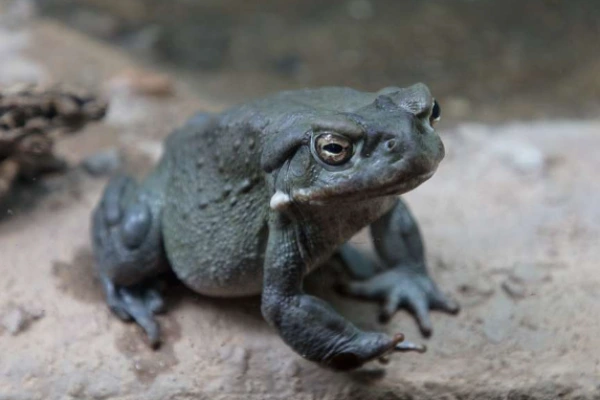
| Scientific Name | Incilius alvarius |
| Size | 7.5 inches |
| Habitat | Lives in variable conditions – deserts and streams |
They have specialized parotoid glands located just behind their eyes. These glands produce a potent poison as a primary defense mechanism against predators and threats.
The poison contains psychoactive compounds, most notably 5-methoxy-dimethyltryptamine (5-MeO-DMT) and bufotenin.
When vaporized and inhaled, these compounds induce strong and rapid psychoactive effects in humans.
People feel warm sensations, euphoria, and intense visual and auditory hallucinations when consumed.
This poison can be highly toxic and even fatal if ingested.
Of recent, these secretions have been used as a recreational drug, either smoked or consumed orally. This practice is sometimes referred to as “toad licking”.
2) Great Plains toad
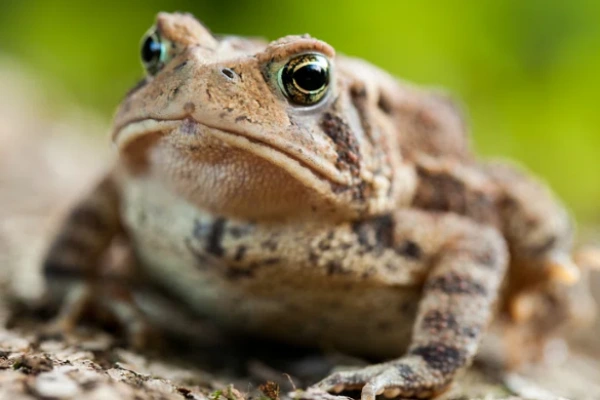
| Scientific Name | Anaxyrus cognatus |
| Size | 2-4.5 inches |
| Habitat | Desert, grasslands, floodplains, and agricultural areas |
While they are not considered poisonous to humans, they do produce a mild toxin on their skin that can influence yard animals such as dogs or cats, causing them to froth at the mouth.
They do this as a result of the toad’s defensive mechanism, where it secretes a substance from its skin when threatened.
They typically reproduce in the spring and summer,mostly in response to significant rainfall. Their mating call is a loud, harsh chirping noise repeated rapidly.
3) American bullfrog
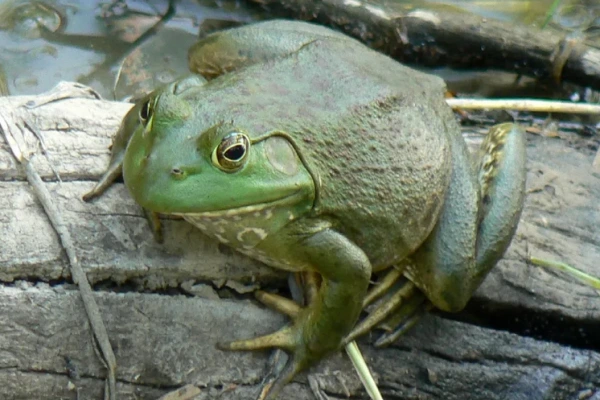
| Scientific Name | Lithobates catesbeianus |
| Size | 3.6-6 inches |
| Habitat | Water bodies like ponds, streams, and lakes |
Like many other toad species, American bullfrogs have parotid glands located behind their ears that secrete poison as a defense mechanism.
This poison is not harmful to humans when touched but can be lethal to small-medium-sized dogs if ingested by them.
Due to their skittish nature, they are often hard to catch making them an invasive species.
They are commonly used for dissection in science classes along with being of culinary importance.
4) Woodhouse’s toad
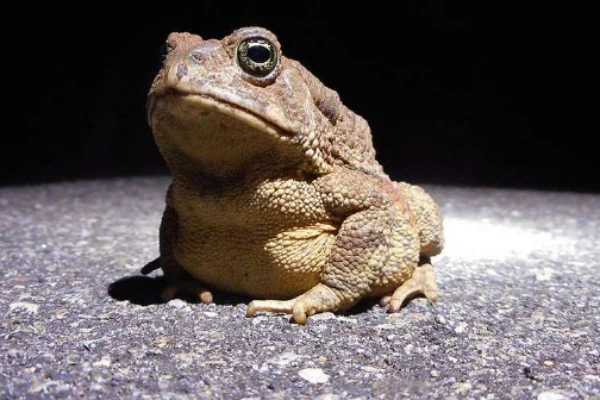
| Scientific Name | Anaxyrus woodhousii |
| Size | 5 inches |
| Habitat | At higher altitudes in wet meadows, ponds, reservoirs, and lakes |
They have poison glands located on the back of their heads.
These glands contain toxic compounds that act as defense mechanism against their poteintial predators.
When threatened by predators, such as dogs or cats, they secrete the irritant toxin from their poison glands causing them to froth from their mouth.
While the toxin is proven to cause damage to certain species, it is completely safe and non-toxic to humans.
5) North American green toad
| Scientific Name | Anaxyrus debilis |
| Size | 1.5-2.1 inches |
| Habitat | Mostly in dry or semi-dry areas |
They have parotoid glands in their skin that release toxins as a defense mechanism when triggered.
These toxins are cardiotoxic steroids, which can be undesirable and potentially harmful to predators.
They are secretive and are mostly found during and immediately after the rainy season when they become more active.
6) Couch’s Spadefoot Toad

| Scientific Name | Scaphiopus couchii |
| Size | 3.5 inches |
| Habitat | Extremely dry areas with well-drained soil |
These toads are named for the hard, dark “spade” on the underside of their hind feet, which they use for burrowing into the ground.
Like some other toads, they have a substance on their skin that can be toxic to humans and pets.
These secretions can lead to allergic-type symptoms in some individuals, including sneezing, and leaky nose.
Their tadpoles hatch quickly and must mature before the pool of water evaporates, sometimes within just nine days.
They are known for their quick development compared to other amphibians.
7) Sonoran green toad
| Scientific Name | Anaxyrus retiformis |
| Size | 2.5 inches |
| Habitat | Dry and semi-dry areas |
They are nocturnal animals and are known to spend most of their time underground.
Like many toads, they possess toxin-producing glands that have serious effects on dogs.
They are specifically found in the counties of Pima and Pinal in Arizona.
Males produce a distinctive buzzing call to attract females.
Their breeding spot include ditches, temporary pools, creek beds, and cattle tanks.
8) New Mexico spadefoot toad
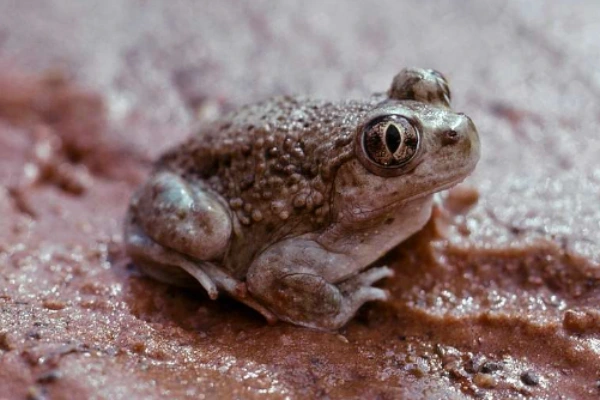
| Scientific Name | Spea multiplicata |
| Size | 1.5-2 inches |
| Habitat | Variety of habitat- desert, grassland, woodlands, and agricultural ground |
Though not poisonous, these toads can emit an odor that resembles roasted peanuts.
This odor may cause tearing, sneezing, and a running nose if the toad is held in close contact with a person’s face.
They are primarily nocturnal and mostly secretive.
The color of their body varies from green to grey to brown, often matching the color of the soil in their native habitat.
They come out of their burrows, during summer rainfalls to feed on insects before explosively breeding.
Conclusion:
In this list we have tried to summarize the 8 toxic toads in Arizona, only the Colorado River Toad, also known as Incilius alvarius, poses a significant risk to humans.
Inhalation of its poison can lead to symptoms like nausea, vomiting, convulsions, and, in severe cases, death.
The other seven toad species, including the Red-Spotted Toad, Great Plains Toad, American Bullfrog, Woodhouse’s Toad, North American Green Toad, Sonoran Green Toad, and New Mexico Spadefoot Toad, do possess poison glands, but their secretions are generally non-toxic to humans.
However, some of these toads may cause frothing at the mouth in dogs or cats if ingested or handled.
It’s important to exercise caution when encountering any wild toads and be aware of potential effects on pets, particularly with the Colorado River Toad.
Also Read:

Hi everyone, my name is Shawna, and I’ve always been fascinated by the fascinating diversity of flora and fauna that our nature has in it. I am currently studying biotechnology and am particularly interested in animal biotechnology, delving into the intricate processes that define their true nature and uniqueness.
